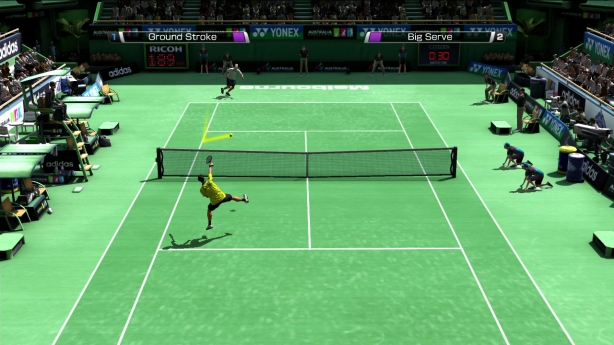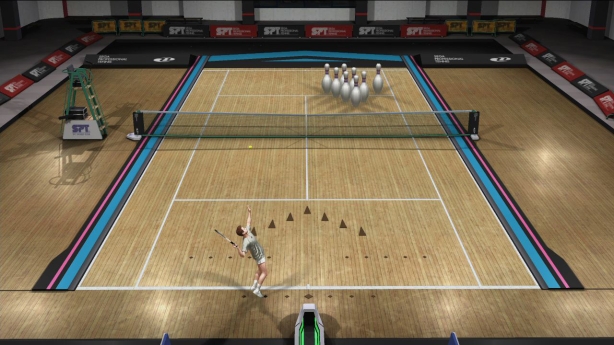Virtua Tennis 4 Review
Developer: SEGA-AM3
Publisher: SEGA
Available on: PlayStation 3, Xbox 360, Nintendo Wii, PC (Reviewed on PlayStation 3)
It has been two years since the last Virtua Tennis game, and many gamers appreciate that SEGA don’t just wheel out the same game each year, iterating upon it in a gradual, piecemeal way. However, with its arcade leanings, Virtua Tennis is a series that feels as though it has been around forever. Given that the last outing felt somewhat definitive, how much further could SEGA really go with an arcade Tennis title?
With PlayStation Move, 3D, and Kinect support, every base is covered in Virtua Tennis 4 and the original development team are even on the case. But for this entry into the franchise, is it enough?
GRAPHICS: As you would expect, Virtua Tennis 4 is the prettiest game in the series to date, with tennis courts that look magnificent. However, there are some serious visual inconsistencies at play. Whilst the players’ animations are an absolute joy to behold, get up close and the non-licenced players can look grotesque! Worse yet, the sweat effect is very strange and gives the created players a wax-like appearance, and let’s not even get started on how strange players’ teeth look!
In play of course, you won’t notice an awful lot of this, but the invasive replays and mini cut-scenes during matches highlight all of the above. During a match, line-judges will frequently have no reaction to getting pelted in the knee or groin with a tennis ball, and when you see a ball boy running across the court, you’ll wonder why they bothered, since a replay or cut-scene will interrupt the flow of the match, again. In that respect, get used to mashing the X button (on a PlayStation 3) to skip these scenes, over and over again.
SOUND: As is normal with a tennis game, there isn’t an awful lot to write home about. Virtua Tennis 4 is a very arcade-style game, and as such, you’ll hear lots of arcade-style noises. The music is horrible, and I eventually resorted to just turning it off. There is no option to simply turn it off during matches yet retain it in the menus, so it’s either always on, or always off.
The sound effects of ball on racquet are great, and the peripheral court sounds are nice too, for example the screeching on an artificial court. Grunting is as it should be, with special mention going to the most camp grunt you’ve ever heard a man make. The crowd is serviceable, which is really all you could ever expect from a tennis title.
GAMEPLAY: The biggest change to the series is in the World Tour mode. Whereas in previous titles, you could go anywhere you want on the map, picking any mini-game you wish, this system has been totally overhauled for Virtua Tennis 4. Now, the career mode is broken down into separate seasons and whilst the map returns, it is totally different. To navigate it, you need to use tickets. These tickets have a value, which is the amount of moves you are allowed to make on that turn (think a dice roll, only with predetermined outcomes).
At first, this seems like an incredibly poor design choice which stops you from picking what you want to do and when you want to do it. After a while however, you’ll start to understand why this decision was made. Virtua Tennis’ career mode has always had a faux-RPG element, but it never really followed through and instead fell back on obscene levels of repetition. With this new ticket system, you don’t end up doing the same training mini-games over and over, and there’s little point in having a favourite because you may not get a chance to play it again for a while.
Throughout the map, there are the obvious locations such as matches, tournaments and rest stops. Now however, there are also management stops, which allow you to buy tickets (you get them automatically when you run out but buying them allows you to pick the value of the ticket manually), rest-tickets, shuffle-cards and eventually sponsorship cards, which allow you to get cash and popularity bonuses. There are also “injury spots”, both minor and major, which will have an effect on your fatigue level, though there are pretty easy to avoid with some careful planning.
As you progress, you unlock all manner of costumes, including fancy dress items that enable you to take part in the special fancy dress exhibition matches. All of this progression is made with a view to earning money and enhancing your popularity, which in Virtua Tennis 4 is displayed with stars. Raising your popularity means you can get into tournaments without qualifying and also adds legs to the career mode, which if played at a reasonable click won’t last all that long. You’ll also unlock play styles as you level up individual skills, which you can switch between (after you have purchased them) before big tournaments.
Aside from the weighty career mode, there are all the usual tropes that you’d expect from a sports title. Exhibition matches, arcade mode (4 matches, then a “final”), practice mode and this time around, the new party mode. If you love the mini-games that always come as part of the Virtua Tennis package, then you might enjoy party mode, which sees you take them on either by yourself or against up to three other friends in whatever order you choose or at random. Rather than selecting a level of difficulty however, you start at level one and progress upwards, gaining a time extension each time you succeed. There are new mini-games to play, such the utterly silly one that involves collecting eggs and returning them to a mother hen. The PlayStation 3 version contains a few exclusive mini-games as well. Party mode is a nice idea, but it isn’t really tennis and it’s hard to believe that anyone would spent much time in it, even if playing with the Move controller.
Also new to this installment of the series is the power shot. If you play well enough, you will build up a power bar which, when filled, allows you to unleash a power shot with the circle button (B button on an Xbox 360). The camera then cuts away, showing a stylised view before cutting back to real-time. Whilst a nice touch, these power shots are far from unstoppable, so when the AI uses them, most of the time a skilled player will be able to return the shot and even win the point. In that respect, the cut-away is yet another immersion-breaker.
Playing Virtua Tennis 4 on PlayStation 3 means you can, if you choose, play the title with the PlayStation Move motion controller. Sadly (and it has to be said this is a massive oversight), this is only available from the main menu in either exhibition or party play. Consequently, there is no motion-controlled career mode for Virtua Tennis 4!
Motion control feels pretty accurate, but there is little skill involved in playing it this way. You could easily sit down, swing at each ball and eventually win. The Move controller feels great, and is shaped in such a way that it feels like you are holding a tennis racquet. However, when you realise the accuracy isn’t transposed to the on-screen action nearly as directly as you would hope for, the draw to playing the game this way quickly fades.
The problem is exacerbated by the fact that throughout a match the camera will switch from first person to third person, from service to regular play. The excitement that was palpable during previews for this mode, with rumours of Move-enabled multiplayer online play are all sadly forgotten, replaced with the feeling that motion controls for this particular title are just a tacked-on feature, with no real skill required.
Worse still, booting up the game with the Move controller does not allow you to get past the title screen. You cannot get rid of the “Press Start To Continue” sign until you turn on a DualShock3 controller and press start on that! Unfortunately, the fact that the main menu contains a “Motion Play” option suggests that appealing to both Move and Kinect has hampered what could have been.
Despite this, Virtua Tennis 4 has incredibly well-animated players and eventually gives you a real feeling of mastery that only the best sports titles allow you to feel. However, there is also a strong sense that a lot of features have been thrown into the mix, when the development time might perhaps have been better focused elsewhere.
LONGEVITY: The career mode will take 5-6 hours (depending on the difficulty) on the first play-through, but the random nature of the ticket system means that you’ll probably play it again and again, trying to reach the top echelons of the tennis world. The multiplayer will be the eventual draw though, and if enough people keep playing it, it will last as long as it takes for you to get bored with playing tennis against people across the length and breadth of your chosen online network.
VERDICT: Despite the motion controls being a big let-down, and some strange graphical anomalies, Virtua Tennis 4 plays a great game of tennis. If you can get together a gang of like-minded people to play online, you’ll be playing it for months on end. It sticks very clearly to its arcade roots, and never strays too far from previous entries to the franchise. But if you loved these entries, there are just enough changes to warrant a comeback.
Online multiplayer could not be assessed due to the PlayStation Network being unavailable.









